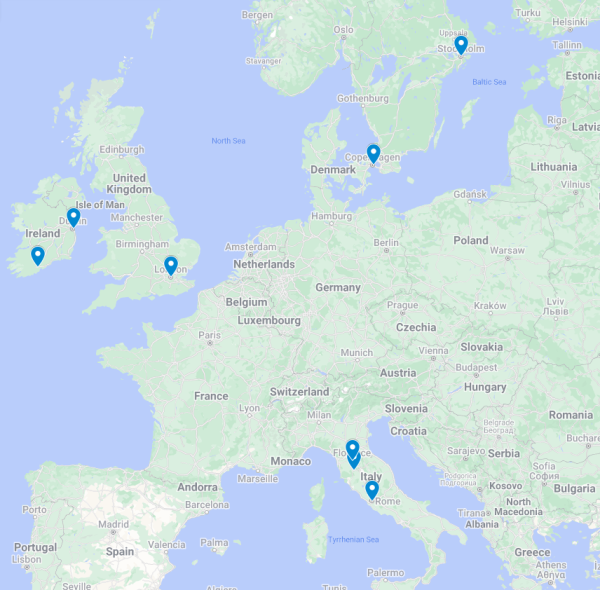Russia begins invasion of Ukraine, 160 strikes reported
Editor’s Note: This article was last updated at 5:00 p.m. Thursday, Feb. 24. According to the Associated Press, Russian troops entered Ukraine’s Donbas region early Thursday morning in response to a signal given by Russian President Vladimir Putin.
In a speech broadcast that aired on Russian television, Putin spoke more about the reasons behind the premeditated attack.
“I have decided to conduct a special military operation,” Putin said, “Russia cannot ex- ist with a constant threat emanating from the territory of Ukraine.”
In response to this move made by the Russian military, Alexander Vindman, a retired lieutenant colonel for the United States Army and director for European affairs for the National Security un- der former President Trump spoke about the invasion.
“Putin has declared war on Ukraine,” Vindman said. “The objective is to demilitarize and pacify Ukraine. This is basically the worst-case scenario. Putin wants to destroy Ukraine’s armed forces and install a puppet regime.”
CNN and The New York Times reported that several loud explosions were heard near Ukraine’s capital, Kyiv following Putin’s declaration of a military operation. According to CNN, there have been about 160 strikes targeting various sites near Kyiv.
According to CNN, these explosions were heard in other regions of Ukraine including the Black Sea port city of Odesssa and the northeastern city of Kharkiv.
It is believed that the explosions that were heard near Kyiv and Odessa were likely missiles, while the ones that were heard in Kharkiv were likely artillery because of the proximity to the Russian border.
and Ukraine has continuously escalated in recent years, sparking fear of potential war in nations across the globe.
According to a timeline produced by The New York Times, tensions began in 2014 when a group of protests in Ukraine overthrew the president at the time, Viktor Yanukovych in hopes that Ukraine would be able to form better relations with the European Union and the North Atlantic Treaty Organization.
These protests, which are also known as the Revolution of Destiny, resulted in the deaths of more than 100 people in the main square of Kyiv.
Later in 2014, Russia in- vaded and annexed Crimea, the southern peninsula of Ukraine, as a result of the re- moval of Yanukovych from office.
President Vladmir Putin sought to annex Crimea to protect the ethnic Russians living in this region from the far-right extremists, whom officials in Russia believe to have overthrown President Yanukovych.
“I told all my colleagues, ‘We are forced to begin the work to bring Crimea back into Russia,’” Putin said in a 2015 documentary produced by VRPO.
According to Ukrainer, Russia is responsible for multiple human rights abuses, such as torture, detention, forced disappearances, as well as discriminatory actions, including the persecution of the Crimean Tatars, a mainly Sunni Muslim Turkic ethnic group.
Additionally, an article from The Washington Post explained that the armed conflict in eastern Ukraine has resulted in the deaths of 14,000 people since its origin in 2014. Kenneth Pinnow, professor of history and global health, made this statistic more tangible, remarking that the number of people that have died since the Revolution of Destiny is the same size as Meadville.
Sasha Shafran, ’25, a student from Ukraine spoke about the shifting tensions between the two nations.
“To be honest, unfortunately, nothing has changed since 2014,” Shafran said. “The only difference is the publicity of the conflict. (Russia’s continuous aggression towards Ukraine is) helping the world to open its eyes on the current events and recognize Russia as a violative country.”
Putin continues to believe that Russians and Ukrainians were the members of one nation and that those in charge of Russia started an “anti-Russian project.”
According to a Washington Post article from last Decem- ber, the Kremlin started planning a multi-front offensive attack.
An administration official from NATO spoke to the Washington Post about what could be expected from this attack in Ukraine.
“The Russian plans call for a military offensive against Ukraine as soon as early 2022 with a scale of forces twice what we saw this last spring during Russia’s snap exercise near Ukraine’s borders,” the official stated. “The plans involve the extensive movement of 100 battalion tactical groups with an estimated 175,000 personnel, along with armor, artillery, and equipment.”
However, President Biden has sought out a diplomatic solution in Ukraine.
Pinnow provided a few different solutions that might prevent the Russian invasion of Ukraine.
“What the Russian government is asking for is legal guarantees that Ukraine will never join NATO,” Pinnow said. “Putin is talking about litigating the end of the cold war. They’re even calling for NATO to leave Eastern European countries like Poland, the Baltic nations or Romania.”
NATO was founded in 1949 as an intergovernmental alliance between the militaries of 27 European countries, two North American countries, and one Eurasian country,
and is meant to ensure the freedom and security of its members through political and military means.
Putin has warned the current members of NATO that if Ukraine is permitted to join, they could be drawn into a full-scale war.
According to an article published by the Independent, Biden warned Russia of what could happen if they were to invade Ukraine.
“I’ve had numerous discussions with the Russians, and particularly with Putin,” Biden said. “I don’t know that he knows what he’s going to do, and I think he has to realize that it would be a gigantic mistake for him to move to Ukraine. The impact on Eu- rope and the rest of the world would be devastating, and he would pay a heavy price.” U.K. Prime Minister Boris Johnson also spoke about how an invasion of Ukraine would, “be a disaster for not just Russia, it would be a disaster for the world,” and discussed how “the UK stands squarely behind the sovereignty and integrity of Ukraine.”





